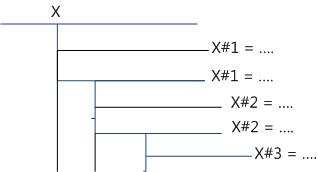It is created as any List for Overhead, but the attribute is List (Tree structure).
Creating a Structure is the second step. This associates the various levels.
Example: List X

Insert the columns into the Expanded WBS and/or (depending on the "Entry allowed" attribute) the Minutes view:
▪X is the terminal element (selectable ID)
▪X•1 is the highest-level element (read only)
▪X•2 is the second highest-level element (read only)
▪etc
where • = # (ID) or $ (Name).
Select a value for X among the values of terminal elements. Due to the structure, this determines the ancestor of a given level (X•1, X•2, ...).
In the Expanded WBS, the value of a chapter is passed down to branches.
In the Minutes view, the range of selection may be restricted if the list is the slave of another as described in Defining Slaves Lists (combinations).
Main Uses
▪Breakdown keys of a field in the overhead workbook or WBS
▪Operand in formulas; the mnemonics are X_1, X_2, ... (IDs) and X_DESC_1, X_DESC_2, ...(Names)
▪Reports, especially the pivot type: to consolidate the report on level 1, drop X•1 in the row area. To exemplify this, we publish a balance of matter on top level for the 1st_Demo_ Estimate_Basics sample:
Matter Balance